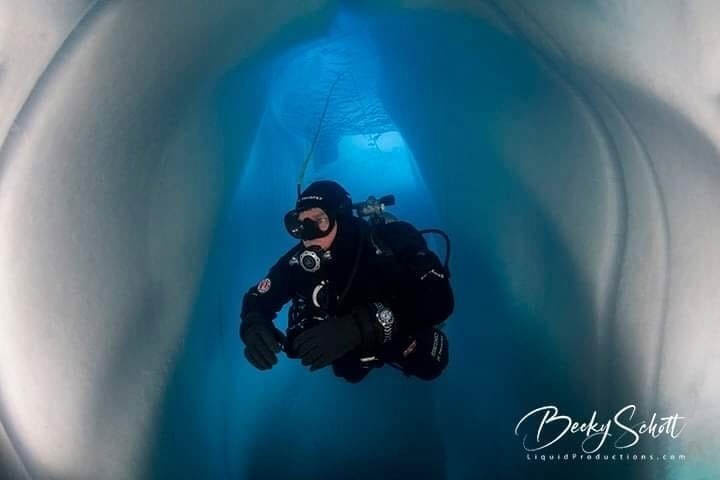I don’t often use the word “epic,” but this is the most epic expedition I have ever planned. I could not be more proud of the team that helped accomplish this unique experience of diving in a glacial moulin in Alaska. Only a handful of people have ever tried this. A moulin is basically a sinkhole in a glacier, a vertical channel in ice that is formed in a glacier by flowing water. These crevasses can be dry or water-filled. They are part of a glacier’s internal “plumbing” that carry meltwater from the surface to deep inside and under the glacier. The water-filled moulins might be still, have a little drainage, or have a plug which can suddenly release if the glacier moves, causing the water to drain very quickly and forcefully. This is why glacier diving is very rare and challenging: this is not a tourist diving destination. We set out to dive these in the winter when the glacier would possibly be more stable. We had seven to 14 inches of ice on the surface, depending on the location. After Alex cut the ice hole, the water would steam like a hot tub: the balmy 32f water was much warmer than the-15f / -26c degree air temps. The hole would instantly start icing back over, requiring regular clearing. We had an extensive safety plan in place, as well as very experienced topside support. We used harnesses and ropes that were tended on the surface and anchored in by ice screws. If the moulin suddenly drained, we would have a chance at making it out.
Our ride was a R44 helicopter operated by Mark and it ran like clockwork. We had to take multiple flights each way every day to move gear and people out to our basecamp on the glacier. The ride was amazing flying over mountains, moose and a few sheep. We only had about 7 hours of daylight to work with so every hour counted. Everything froze. We experienced gear issues in the freezing temps that I’ve never experienced before. Masks covered in ice, inflators freezing shut instantly, 7 reg failures in one day, ice forming in front of our eyes on the cameras dome ports and on our Seiko Ice Diver watch faces. My safety rope even froze to the glaciers ceiling at one point. I had equipment issues I have never encountered before.
We were most definitely on the edge of what we could physically do and the limitations of our gear. When we finally got underwater, the experience was magical, worth every bit of effort. I was blown away by the gin-clear water. It felt like swimming in air! We had just entered an ice cave, pure white glacial ice in every direction. The formations and cracks in the ice were stunning. Tunnels and long pressure cracks that refilled with clear ice just stood out as they flowed down the walls at least 30 feet. There were tunnels heading into the glacier, and light just bounced off the reflective white surfaces. We swam about 100 feet down one of the tunnels before it got very narrow and headed deeper into the glacier. We experienced formations that looked like giant egg cartons, and even ice so clear it froze bubbles into it. I ran my hand along the smooth, cold, and silky ice wall, just amazed at it all. I was diving inside a glacier! Someday this piece I just touched will calve off and become an iceberg. The thought of that just blew my mind.
I personally spent a total of four hours underwater on four dives in two different locations. One of the dives was 100 minutes. When I surfaced after the dive that day, my dry gloves were covered in ice and frozen in place on my Santi dry suit. My watch was encased in ice and frozen to my suit as well. In fact, about the only gear that had no failures in the extreme cold were the Seiko Ice Diver watches; they all kept happily ticking away. We really put those watches to the test, and I was truly impressed. I find it hard to truly wrap words around this amazing adventure and incredibly beautiful place. A challenging project such as this requires an experienced and professional team. For this to be a success, Everyone toughed it out and we got to explore and come back with some incredible images. These were long days and at night we would hit our beds, bodies aching, feet still cold, noses still sore, worn out. But oh man, it was worth it!
This expedition would not have been possible without the expert surface and air support of Alex Fancher Mark Fleenor along with my dive team Jeff Lindsay and Rick Witter. We spent months planning this in great detail. Also a big thanks to Bryan Smith and David Pearson from Reel Water Productions for capturing the entire journey. I can’t wait to see the final video! Lastly thank you to Seiko Luxe USA for supporting adventure and exploration! I hope to return, maybe in the summer when it’s “warmer and my eyelashes won’t be frozen together!
Becky Schott
Story Submitted by Becky Kagan Schott Of Liquid Diving
Follow Becky’s Dive Adventures on Facebook, Instagram and Twitter







